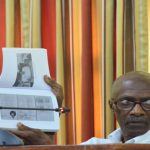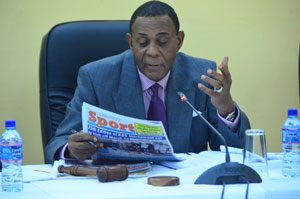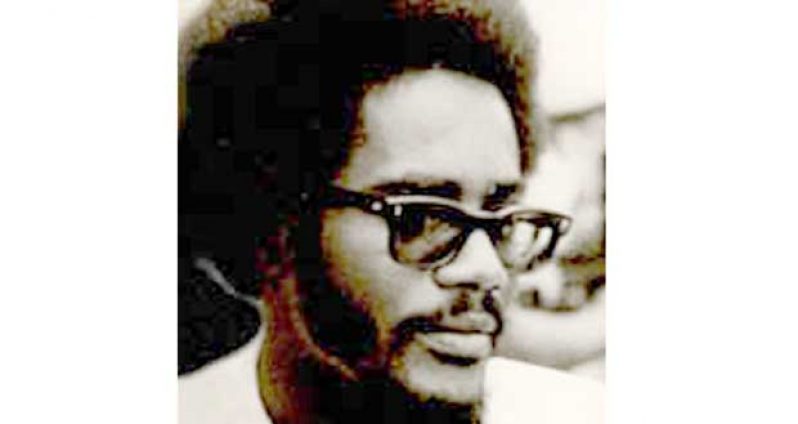POLICE trial records, and published accounts of the June 13, 1980 explosion that killed Dr. Walter Rodney and its related events, were all rejected as concoctions, fabrications and outright falsehood, when the lone witness and brother to the slain Working Peoples Alliance (WPA) leader returned to the witness stand of the Presidential Commission of Inquiry (COI) yesterday. Donald Rodney reappeared before the commissioners and, in his evidence-in-chief , rejected a number of accounts of the events authored by former Guyana Defence Force (GDF) Sergeant Gregory Smith and his sister Ann Wagner, and published under the title “Assassination Cry of a Failed Revolution: The Truth about Dr. Walter Rodney’s Death”.
In the book, the authors allege that Smith was in the car with Dr. Walter Rodney and Donald Rodney on several nights, a charge that the surviving Rodney vehemently denied.
In Smith’s book, he alleged that Donald Rodney knew fully well that his brother was looking to secure the services of ranks in the GDF.
GDF MERCENARIES
Smith, in his book, alleges too that Dr. Rodney, along with his brother Donald, were complicit seeking out the ranks that had either felt disenfranchised, or had money or other drug related issues.
According to Sergeant Smith’s account, Dr. Rodney was actively looking for men who did not necessarily hold any political ideology, but would more or less work as mercenaries in aiding the supply and transport of arms and ammunition.
This too was a charge vehemently denied by Donald Rodney, who was led in his evidence-in-chief by Attorney-at-Law, Keith Scotland.

Rodney also dismissed all of the allegations that had been detailed in Smith’s book in relation to detonators and tests with Gregory Smith and Dr. Rodney driving along in the same car.
Following the explosion that killed Dr. Rodney in 1980, Donald Rodney was charged with the unlawful possession of explosives.
FABRICATIONS/CONCOCTIONS
Rodney was shown copies of police statements and records from his trial, but he rejected their contents telling the Commission that which is recorded, he did not say.
In fact, Donald Rodney told the Commissioners that at his trial, none of the reports of any of the bomb experts that had been flown in or the pathologist had been presented, an allegation that seemed unusual to the learned COI Chair Sir Richard Cheltenham and Queen’s Counsel Jacqueline Samuel-Brown.
There were numerous attempts to differentiate between what was Donald Rodney’s sworn from unsworn testimony from the 1980s Court records.
Rodney told the Commission that everything documented in the court records is ‘a total fabrication.’
It was put to Donald Rodney, by his attorney, that in the records of a Police Assistant Superintendent, Gentle, who had recorded that when his home was searched, walkie talkies, plans and other subversive literature were found.
VIOLENT END
The police officer concluded that Dr Rodney was looking to secure political power through revolutionary violence but met a violent end since he was not conversant with explosives.
The police rank at the time, in his report, said that both Dr. Rodney and his brother, Donald Rodney, knew very well what they had in their possession was an explosive.
Rodney, from the witness stand, continued to profess his innocence and through his attorney, recalled that none of the plans, walkie talkies or subversive literature purportedly found at his house were ever presented at his trial.
Donald Rodney said that the only plans he knew to be at his house at the time were in relation to examination papers he was marking as part of his job at the University of Guyana, and they were in fact building plans with electrical and other plumbing drawings.
Rodney told the Commission that prior to the 1980 events that led to him collecting what he believed to be a home-made walkie talkie for testing, he had never actually seen a walkie talkie, home-made or otherwise.
“I didn’t know it was an explosive before the impact,” maintained Donald Rodney.
The witness recalled too, that in retrospect, Dr. Rodney could not have intended to blow up the Georgetown Prison walls.
He pointed to the size of the explosive and its distance from the prison and questioned how the walls of the Georgetown Prison could have been a target.
FRIDAY, 13 JUNE, 1890
Recalling the fatal night of Friday 13, June 1980, Rodney recalled that when he collected his brother, they drove to Gregory Smith’s home at Russell and Howes Street in Charlestown, and he left his brother in the car to go collect the ‘walkie talkie’ for another night of tests.
He recalled that Smith was surprised to see him and asked where his brother was.

According to Donald Rodney, he was informed by Smith that two tests would be conducted that night, one in Princess Street and the other in the vicinity of the Georgetown Prison.
It was explained to him that there was a need to test the effect of the transmission against the expansive metal walls of the prison.
Rodney told the Commission the package he collected was a box in a brown paper bag weighing between one and two pounds and he assumed it was the same device he collected a few nights earlier to conduct similar tests.
Smith, according to Rodney, indicated to him that there was a knob on the side of the box already in place for the first test on Princes Street and when in the vicinity of the second location, the Georgetown Prison, he would need to turn the knob and wait for the second signal—a flashing light.
WATCHES SYNCHRONISED
At about 7:50pm that evening, according to Donald Rodney, Sergeant Smith indicated to him that they needed to synchronize their watches and that the first signal could be expected at 8:00pm.
Smith, according to Rodney, suggested that the two walk to the location and according to the witness, when he returned to the car “I told Walter who was still sitting on the front passenger seat that we should start walking.”
He testified that the plan was to brief his brother on Smith’s instructions as they walked to the location; but Dr. Rodney insisted “we should drive.”
Donald told the Commission that he repeated Smith’s instruction to walk and “he (Walter) said again that we should drive, that he didn’t think it would make a difference.”
He continued to tell the Commissioners that he went along with his brother’s suggestion after handing him the package.
Test #1
“We were parked in Howes Street and I continued in Howes Street towards Adelaide Street, we turned left into Adelaide Street until we came to Princes Street, I went just over Princes Street and I parked in John Street near Princes Street,” according to Donald Rodney.
Having parked in John Street, in the vicinity of Princes Street, Donald Rodney told the Commission that after turning off the engine they waited on the appointed time, at which point there was a flash from the package “and Walter remarked that it is ok.
Donald Rodney recalled that it was at this point in time that he indicated to his brother the need to turn the knob on the box to the secondary location for the second test.
“As far as I could recall, he did it and we then drove off again north along John Street,” said Donald Rodney.
He continued: “we went up to Durban Street, across Durban Street continuing past the jail, continuing past Bent Street and we continued going onto Hadfield Street, at Hadfield Street I stopped the car.”
LOUD THUD
Continuing with his evidence in chief, Donald Rodney testified, “We waited for the second signal,” but none came.
In giving his testimony of the seconds before the horrific explosion, Rodney said his brother was about to tell him something in reference to “I believe Gregory Smith, because, he said tell him, who the him was, wasn’t explain further because at that point I felt a vibration and heard a loud thud.”
Revealing his story for the first time to a public hearing in 34 years, Donald Rodney testified, “At the same time I hear a loud thud, I felt my body being pushed out of the car against the car door.”
Having recognised the impact on his body, Rodney was asked to recall what happened next, at which point he said, “The door on my side flew open and I was aware of the dashboard lights coming on even though at that point in time I was already blinded on the left side.”
According to Rodney, he soon realised that the loud noise was an explosion on his brother’s side of the car.
“I felt I needed to get help for him,” said Rodney, who by this time had made his way out of the vehicle and recognizing that his brother had been injured, ran along John Street towards the home of Dr. Omawale.
According to Rodney, when he arrived at the house, he shouted out at the side of the building and was greeted by either Karen DeSouza or Andaiye.
During his testimony, Rodney said he could not recall specifically which one of the persons he spoke with, but indicated to that person, “something terrible had happened.”
While Dr. Walter Rodney was killed instantaneously in the explosion, his brother Donald, testified that he suffered lacerations to the throat, right thumb, puncture wounds with fragments embedded in his left arm, side, face and eye, along with a puncture wound to his right elbow.
Donald Rodney testified too that as a result of the explosion, he also suffers long-term effects in the form of impaired vision and hearing, as well as nerve damage to his right hand.
The Commission of Inquiry will resume today with a visit to the scene of the 1980 explosion by Donald Rodney, Commissioners Sir Richard, Queens Counsels Seenauth Jairam and Jacqueline Samuels-Brown along with other stakeholders and attorneys with vested interests.




.png)









